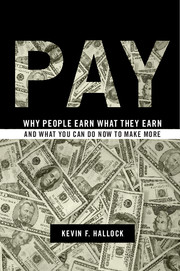Book contents
- Frontmatter
- Contents
- Figures
- Tables
- Acknowledgments
- PART I HOW HARD CAN THIS BE?
- PART II HOW ORGANIZATIONS SET PAY STRUCTURE AND WHY
- PART III HOW PEOPLE ARE PAID CAN MEAN AS MUCH AS HOW MUCH THEY ARE PAID
- 9 Evaluating Performance, Incentives, and Incentive Pay
- 10 Stock and Stock Options
- 11 Pay Mix
- 12 International Compensation
- 13 Compensation in Nonprofit Organizations
- PART IV WHAT YOU CAN DO TO MAKE MORE AND CONCLUDING COMMENTS
- Notes
- References
- Index
10 - Stock and Stock Options
from PART III - HOW PEOPLE ARE PAID CAN MEAN AS MUCH AS HOW MUCH THEY ARE PAID
Published online by Cambridge University Press: 05 October 2012
- Frontmatter
- Contents
- Figures
- Tables
- Acknowledgments
- PART I HOW HARD CAN THIS BE?
- PART II HOW ORGANIZATIONS SET PAY STRUCTURE AND WHY
- PART III HOW PEOPLE ARE PAID CAN MEAN AS MUCH AS HOW MUCH THEY ARE PAID
- 9 Evaluating Performance, Incentives, and Incentive Pay
- 10 Stock and Stock Options
- 11 Pay Mix
- 12 International Compensation
- 13 Compensation in Nonprofit Organizations
- PART IV WHAT YOU CAN DO TO MAKE MORE AND CONCLUDING COMMENTS
- Notes
- References
- Index
Summary
Executives in most American companies are paid some form of their compensation in stock and stock options. Stock is a fractional ownership in a company. If a company has 1,000,000 shares of stock and you own 100,000 shares than you own one-tenth of the company. You can vote for board directors and shareholder proposals and can sometimes earn dividends (like interest) on your share ownership.
Some executives are paid in part in company stock. Suppose the stock is trading at $30 per share. If an employee is given 100 shares of stock as part of her compensation, then this is equivalent to paying her $3,000. In many circumstances, stock offered to employees is restricted in some way or another. A common restriction is for the stock to require vesting. A common form of vesting is time vesting, in which the stock cannot be sold by the employee for some time, for example a year. Some companies require what is known as performance vesting. In this case, the stock cannot be sold until some measure of performance is met (for example, the stock price increases to a certain amount or some other performance e.g., a level of profitability metric). Some companies pay in stock so as to make the employees feel like owners. Some companies require executives to keep (hold) a certain multiple of their company stock. This is called a holding requirement.
- Type
- Chapter
- Information
- PayWhy People Earn What They Earn and What You Can Do Now to Make More, pp. 125 - 134Publisher: Cambridge University PressPrint publication year: 2012



